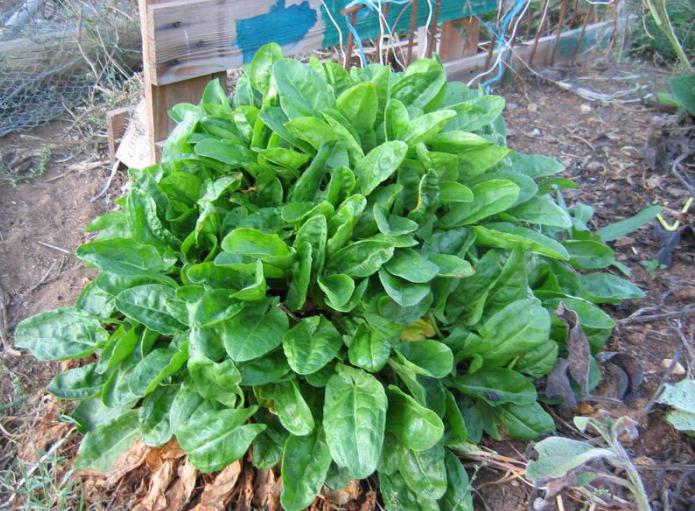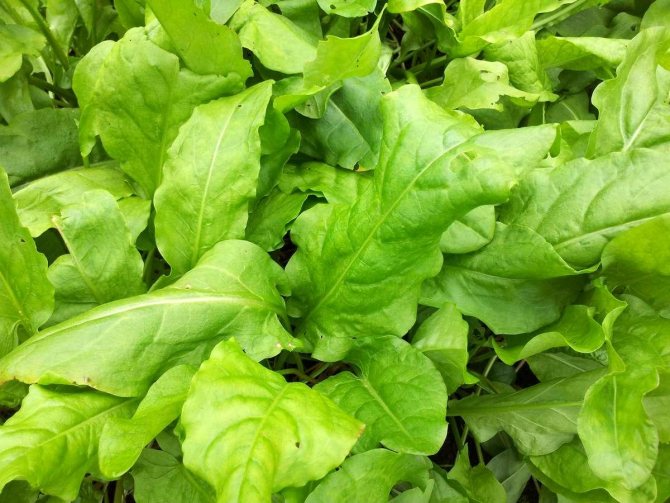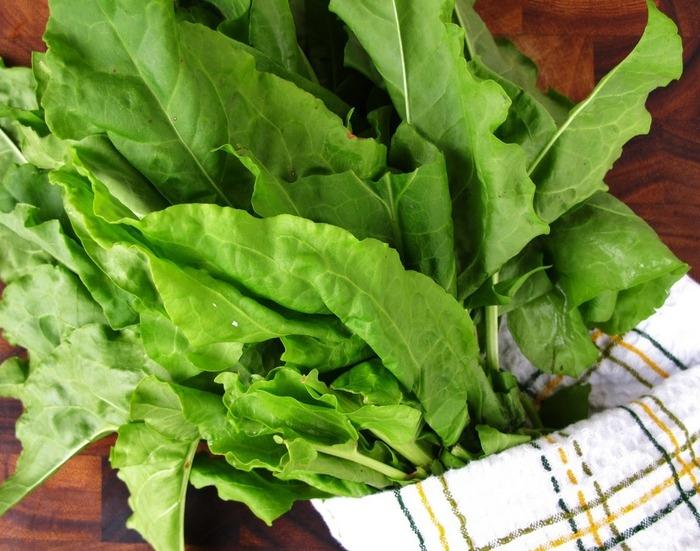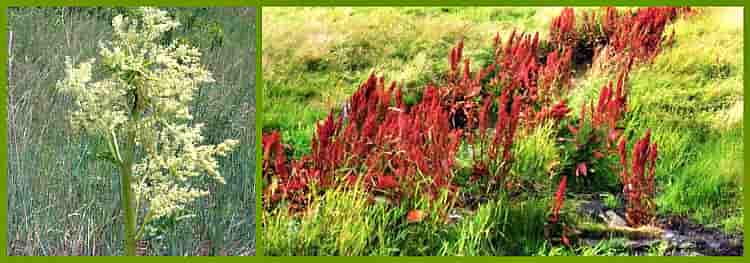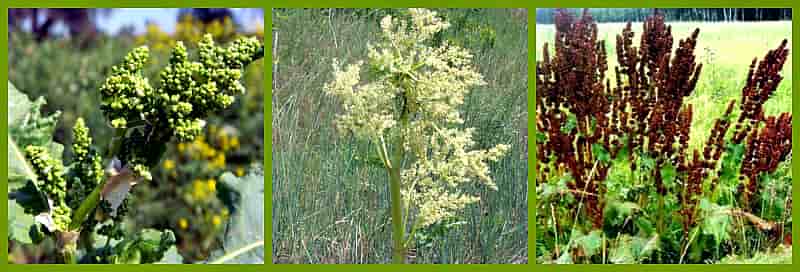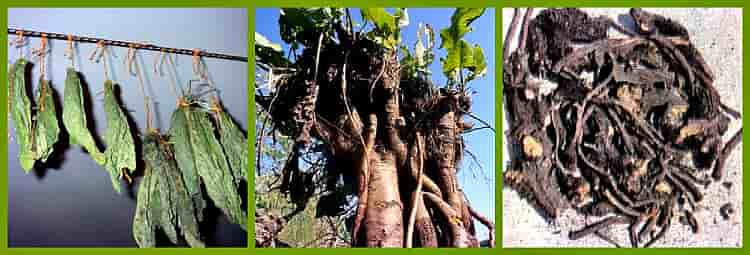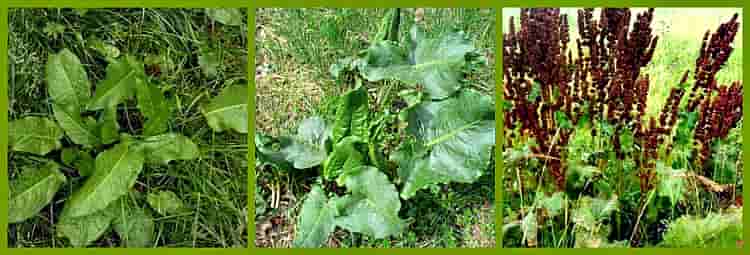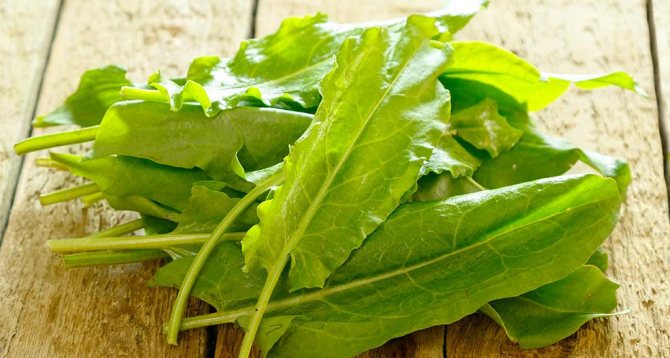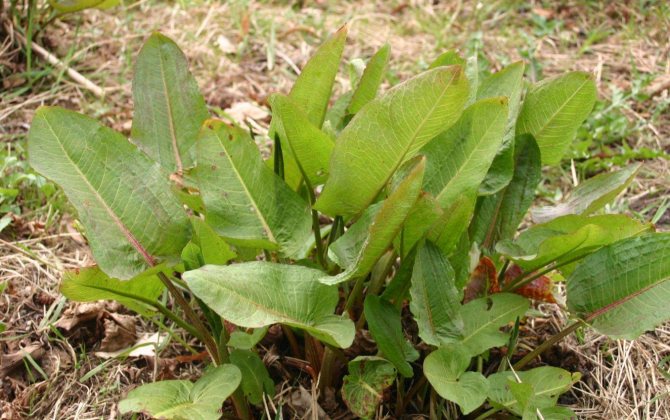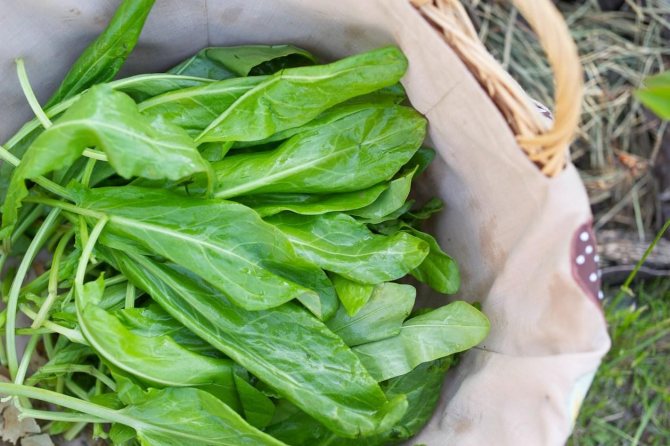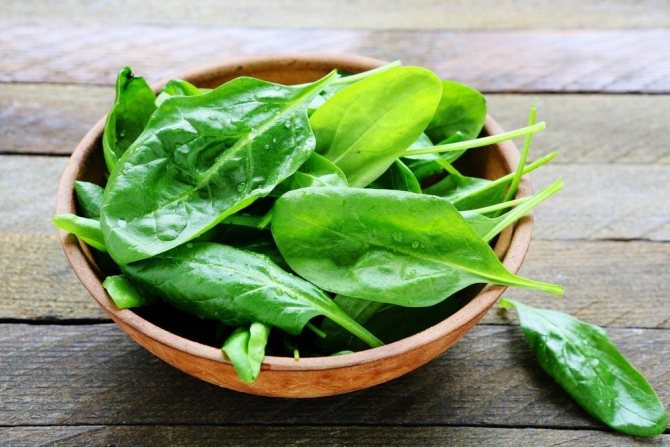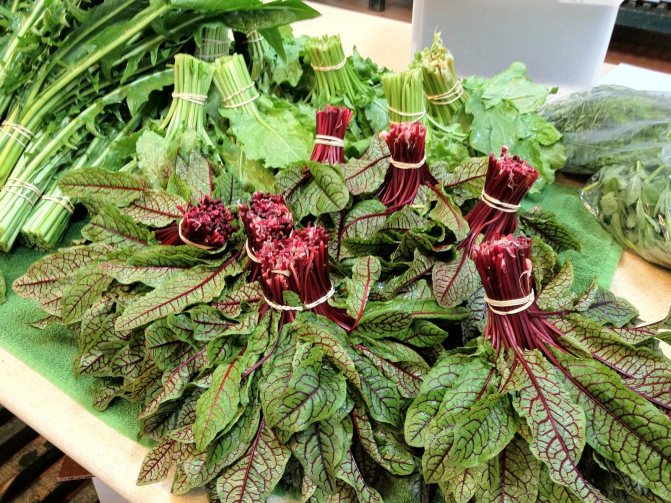In cooking, three types of sorrel are usually used: ordinary (R. acetosa), corymbose (R. scutatus) and small sorrel (R. acetosella).

Sorrel
Growing sorrel is easy, but its fresh lemon flavor will add a piquant sourness to both vegetable salad and soup. Coastal sorrel ("British grass", according to Pliny) will not cause much delight in the gourmet, but Julius Caesar successfully treated his soldiers from scurvy with it.
Other names:
- sour sorrel (common sorrel)
- sour sorrel
- sorrel
- sorrel (small sorrel)
Parts used:
- leaves
- roots (only for curled sorrel)
Common sorrel
Cold-resistant perennial 1-1.2 m high with bright green leaves up to 15 cm long. Its tiny reddish flowers are collected in tall ears. The height of corymbose sorrel is not more than 30 cm; it has light green leaves and greenish flowers.
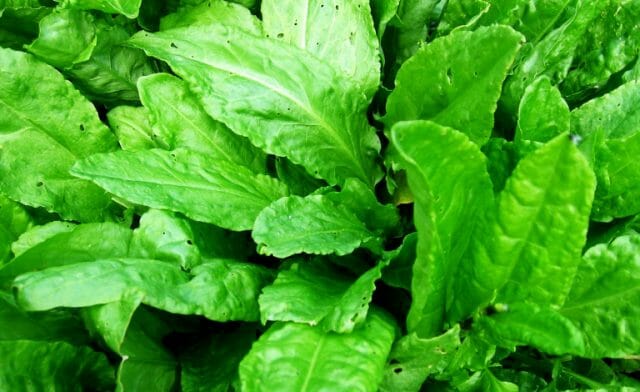

Common sorrel
Varieties
"Blond de Lyon" (common sorrel)
Classic sorrel cabbage soup is cooked from large fleshy leaves of the variety and blue and green dyes are obtained.
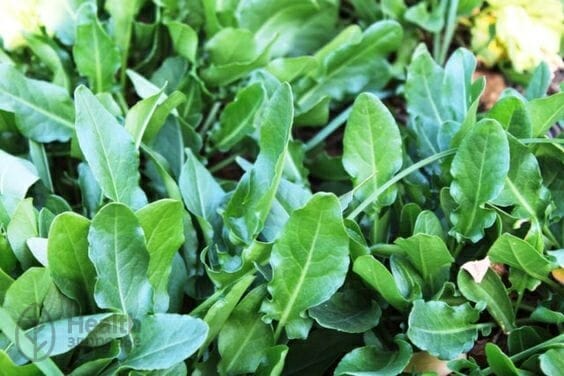

"Blond de Lyon"
"Silver Shield" (corymbose dock)
The variety has silvery foliage.
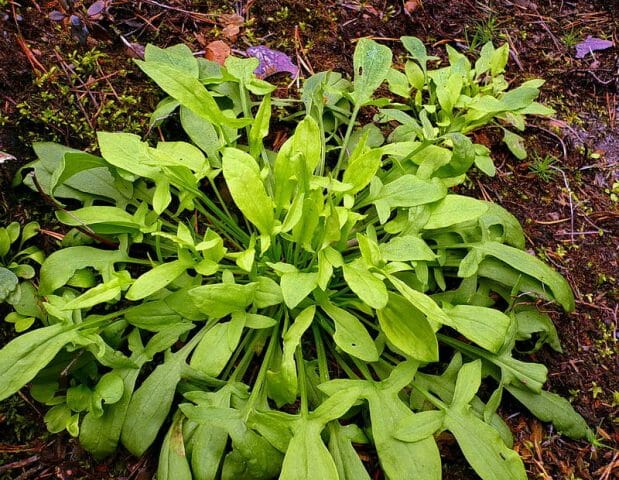

Sorrel corymbose
Chemical composition
Horse sorrel is not only a well-known plant, but also a well-studied one. Scientists, doctors, beauticians and traditional healers know about its rich chemical composition. First of all, experts say that sorrel is a whole storehouse of various useful substances. These are organic acids - oxalic, caffeic, lactic, citric and chrysophanic acids with all its derivatives.


The plant generously shares vitamins C, K, P, flavonoids, pectins, iron, essential oils, coumarins. In addition, tannins (or tannins) make up 15–16% of the mass of dried plant raw materials, their action is based on the use of plant raw materials in leather production, and due to the presence of carotene (plant pigment) it is used in the manufacture of dyes for black and yellow fabrics. The picture of sorrel components is completed by the presence of various trace elements (magnesium, sodium, phosphorus, manganese, fluorine, calcium, copper).
Contraindications
Sorrel preparations should not be taken by pregnant and lactating women. The seeds of the plant are not recommended for people with kidney disease. Oxalic acid, which has entered into a chemical reaction with calcium, can provoke the appearance of oxalate stones. They settle in the kidneys and cause severe pain to a person.
Overuse of sorrel can lead to kidney stones and upset stomach. The seeds of the plant are contraindicated for citizens with impaired salt metabolism. People with diabetes may consume small amounts of sorrel. Before using folk remedies, be sure to consult with a specialist. Do not self-medicate.
What it looks like and where it grows
This tall plant is noticeable from afar, it is difficult to confuse it with any other. Its strong stems, up to one and a half meters high, branch out, forming a whole bush, and can reach a thickness of 2 cm. Its leaves are elongated, but of two types.Some form a basal rosette, sit on long stalks and have a rounded top. Their length can be up to 25 cm with a width of about 12 cm. Other leaves are located throughout the smooth stem, their petioles are shorter and slightly reddish at the point of attachment to the stem. The leaves themselves are smaller than the basal ones, narrower and with a pointed top, on the lower side they are covered with short, stiff hairs.
The flowering of the plant begins at the end of May and continues throughout June, the flowers are small, green-yellow, outwardly similar to unripe buckwheat. They are collected in a narrow high dense inflorescence, brown as they ripen. Small fruit-nuts ripen in them, which are able to survive the autumn without falling off, and hang on the stems for almost the whole winter.
In general, the plant is large, powerful, succulent. Surprisingly, the rhizome of such a hero does not differ in special size. It is short and not very branched, but thick and has many adventitious roots.
In the European part of the former USSR, it can be found everywhere, except, perhaps, in the regions of the Far North - not only in Russia, but also in neighboring countries. It grows both in forests and steppes, prefers to settle where there is life-giving moisture in abundance. He loves both the banks of wide rivers and the surroundings of quiet ponds. He does not care for spring floods, but does not tolerate swampy soils.
Forest edges and clearings, roadsides and vegetable gardens, fields and ravines - the horse sorrel feels at ease everywhere. Still, his favorite element is meadows. It can exist both as a specimen plant, decorating the area with its only person, or in a small group of several pieces, as well as occupying entire vast territories - up to several hectares, without giving a chance to life for other grasses and even shrubs. But if such a territory is systematically mowed or livestock released onto it, the sorrel may not resume growth on it next year and simply degenerate.
Collection and storage
To collect horse sorrel, you need to move away from civilization - to fields, forests, meadows, to the shores of natural reservoirs. It is there that the most useful and safe plants grow, and near roads, in settlements or near them, there is a high probability of picking up sorrel, which has absorbed hazardous substances from car exhaust or industrial emissions. You need to choose warm, good weather, without rain.
All parts can be harvested from horse sorrel. Leaves and stems are best harvested in early summer - in June, when the plant is just beginning to bloom, and young tender leaves are even edible, because they are not bitter yet. The collected greens are washed under running cold water and dried entirely; it is important to organize for drying not a sunny, but a shaded and well-ventilated place.
A little later, in July, the collection of seeds begins. By that time they already acquire a red color. The seeds must be carefully sorted out, all the litter must be selected and stored in glass jars.
Both autumn and spring are suitable for harvesting the root - at a time when the green part of the plant either has not yet appeared, or is already dying off. It is more convenient, of course, in autumn, when the aboveground part of the sorrel is still standing, and there is no danger of digging up some other, unknown, but very similar one instead of the required rhizome.
The rhizome is thoroughly cleaned of dirt, washed with running water and placed on a sunny area so that it withers. Crushed by cutting the thick roots in half lengthwise, and then dried to the end on a veranda under a canopy. If the weather is damp and the air is humid, it is possible to dry it in the oven with a low flame and with the door ajar. You can store, like leaves, in glass containers, wicker baskets with a lid or cardboard boxes.
The aboveground part will lie for a year without loss of quality in this form, the root can be stored longer - up to three years.
If it is decided not to dry the sorrel, but to freeze it (this option is also possible), it must be pre-cut and only then put into the freezer. You cannot cut the defrosted product. And do not be afraid of the consistency of thawed sorrel, useful substances are still preserved in it.
How to distinguish horseradish from horse sorrel
An inexperienced person can confuse horseradish with horse sorrel, although they differ. Horseradish grows out of the ground as a huge rosette and on fertile soil can reach a length of 80–100 cm. The color of young horseradish leaves is light green, later they darken and acquire a more intense color. They are quite wide, rounded at the top, and look slightly wrinkled, as if the linen was not ironed. Having bit through the leaf, you can feel a slight burning sensation, which is not the case with horse sorrel.
Horseradish blooms rarely and not every summer resident. Some have cultivated this plant for years and do not suspect that it can bloom. Its flowers are small, white, collected in loose, loose brushes - against a dense narrow brush of green in sorrel. There are also some small leaves on the horseradish peduncle.
The flowering dates for horse sorrel and horseradish differ: if the former enters this phase of life in late May - early June, then horseradish - a month later, when the sorrel has already bloomed and the seeds are ripening with might and main. And the roots of these two plants are different: horseradish is almost white, sorrel is much darker, almost chocolate-colored.
What is it - a vegetable or a herb?
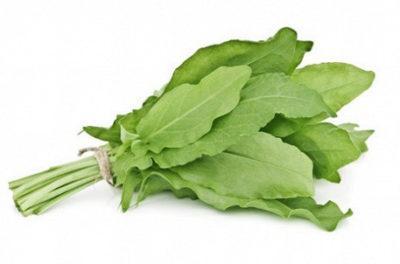

Sorrel is a perennial herb (in Latin - Rúmex, translated means "spear"). Height reaches 90-150 cm. The plant has a thick rhizome and a knobby stem. The stem sometimes takes on a purple color. The lower leaves are directed downward with lobes, and at the base are arrow-shaped.
Flowers can be yellow, pink and red, but they are very small and inconspicuous. Sour sorrel, widespread in medicine (R. acetosa L.). Flowering takes place at the end of June-July. Where does it grow in nature? Common sorrel sometimes grows near roads, on river banks and in weedy places.
The medicinal properties of horse sorrel
Ever since the time of the Persian physician Avicenna, the ability of horse sorrel to put sick people on their feet has been known. It is recognized by both official medicine and folk medicine. Herbal preparations or medicines that include this herb are sold at any pharmacy. First of all, doctors prescribe them for pulmonological problems and in dermatology. So, sinusitis is treated with pills, and solutions are used to remove simple and plantar warts, genital warts, and also fight seborrheic keratosis.


Medicine has long learned to use absolutely every part of the sorrel, but nevertheless, the use of the root is considered the most effective - due to the maximum concentration of nutrients.
- Potions from horse sorrel give in to diseases of the digestive system, liver, skin, respiratory organs, in particular bronchitis.
- In atherosclerosis, sorrel reduces the amount of cholesterol, fights deposits in the vessels, dissolving atherosclerotic plaques. It has the ability to alleviate the condition of hypertensive patients, relieves headaches.
- The astringent effect of sorrel, obtained thanks to its tannins, is widespread in the treatment of diarrhea, colitis and enterocolitis. The plant is also used as a choleretic.
- The hemostatic effect of sorrel is also known, therefore it is prescribed for intestinal, pulmonary, gastric and uterine bleeding, as well as for hemorrhoids.
- It is also used as a bactericidal and immunostimulating agent; it is used by dentists, dermatologists, and gynecologists. Eczema, scabies, wounds, boils - horse sorrel successfully copes with all these problems, and heals a sore throat with angina. As a bactericidal agent, sorrel is successfully used for dysentery.
- Healers have long prescribed it to weakened and emaciated patients in order to increase their appetite.
Growing a family
Sorrel is planted in early spring, but the soil must be prepared in the fall. The area chosen for planting must be dug up. The best growing soil is peat bog.
Sorrel care is pretty simple, you need to be careful. If the sorrel begins to "need thirst", then almost immediately it will begin to bloom. In addition to watering, the plant also needs weeding. The soil should always be loose and fluffy. Please note that sorrel yields a crop only once a year, so it is better to cover the remnants of roots after cultivation with humus.
Diseases and pests for sorrel:
- Powdery and downy mildew appears with a gray bloom in the form of dark spots. Bordeaux liquid can help to combat this.
- Sorrel leaf gnaw. Plants infect all kinds of pests. Tomato or garlic infusion will help to cope in such a situation.
- Sorrel aphid deprives the plant of nutritious juices. Processing is not required, but after collection it is necessary to pour over the bitter infusion.
Horse sorrel in folk medicine
Horse sorrel has always been popular among medicine men, healers and shamans for its beneficial properties and due to the wide availability of medicinal raw materials. He was recommended as a prophylactic agent for vitamin deficiency, gum disease, offering to chew a young leaf of the plant. Juice from freshly harvested leaves was used to treat migraines, rubbing them on whiskey, and even used as an antihelminthic agent. A paste of sour cream in half with finely chopped sorrel was smeared with problem skin. The juice of the plant was recommended even for complex pathologies, such as early stages of stomach cancer and external manifestations of skin oncology.
Modern folk medicine does not abandon the traditions of the ancient sorcerers and continues to widely use sorrel for these diseases - despite the fact that it must be combined with the treatment prescribed by doctors.
Sorrel juice for skin cancer
It is easy to get sorrel juice with a regular juicer. Take it every hour, diluting 3-5 drops in water. Cancer lesions on the skin are rubbed with undiluted juice. Healers recommend adding 3-5 drops of juice to yarrow tea for those who suffer from Parkinson's disease.
Sedative
Horse sorrel has a mild sedative effect. With the help of the infusion, you can get rid of pain in the lower abdomen during menstruation, since it relieves cramps. This remedy will also help with menopause, putting in order the nervous system and improving sleep. The recipe is simple: pour a tablespoon of sorrel with a glass of boiling water, stand for an hour and divide the composition into three parts, drink it a day - in the morning, at lunchtime and in the evening.
From a hangover syndrome
The ability to reduce hangover syndrome is based on the high content of vitamin C in horse sorrel. Just a glass of infusion is enough: pour 500 ml of boiling water over a teaspoon of green leaves. You can drink in a quarter of an hour. If necessary, you can repeat the procedure in two or three hours.
From cystitis
This problem is very well known to women. Sorrel successfully copes with its solution due to its disinfecting and diuretic properties. Pour 500 ml of boiling water over a tablespoon of leaves, leave for several minutes, drink three times a day.
Slimming
Horse sorrel's ability to improve the digestive system is suitable for those trying to lose weight. This recipe should be used in a comprehensive weight loss program. Grind an apple with a banana in a blender, add 2 cups of boiled water and a handful of finely chopped sorrel. Stir to make a smoothie. Pour into a glass, garnish with a mint leaf and drink.
We advise you to read:
the use of the cuff in traditional medicine
To read
Useful video
We offer you to watch a video about the useful properties and use of horse sorrel:
If you find an error, please select a piece of text and press Ctrl + Enter.
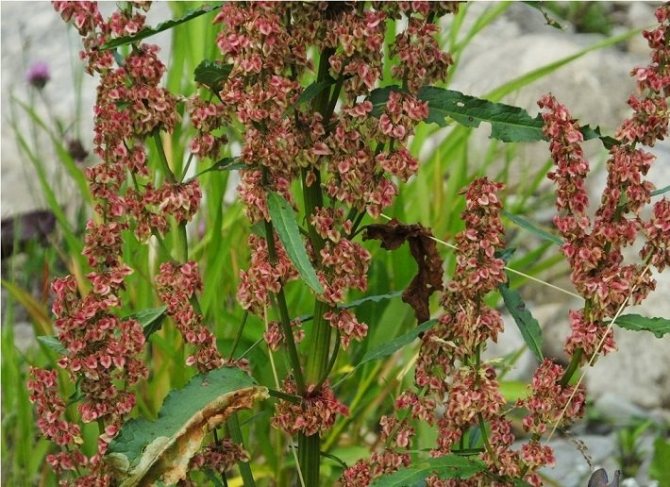

Sorrel is a perennial of the buckwheat family. Its height can reach 1.5 meters. After flowering, many fruits are formed on the panicle in the form of a triangular brown nut. The plant is very common, but few people know about its beneficial properties.
Types of medicinal compositions with horse sorrel
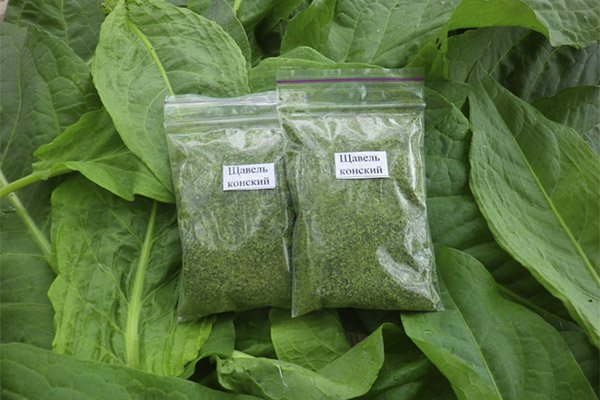

Infusion
- With diarrhea.
With a glass of boiling water, pour 15 g of crushed dried root and the same amount of seeds, steam for 5 minutes in a water bath at medium boil, pour into a thermos, where to leave for at least two hours. It will help with diarrhea, and also as an adjuvant in the treatment of liver problems. - With angina.
You can gargle with infusion: 20 g of dry sorrel (it does not matter - root or herbs) pour a glass of boiling water and leave for 15 minutes. Apply when the infusion has cooled down. - With itchy skin.
An infusion of 20 g of fresh, freshly harvested leaves will help relieve itching. Pour them with a glass of water and boil for 10 minutes over low heat. Wrap well and let stand for an hour. Apply externally, rubbing itchy areas, and inside - drink a teaspoon in the morning, afternoon and evening.
Tincture
To relieve rheumatic pains, an alcoholic tincture is prepared. This will require sorrel seeds and crushed root. Take 10 parts of vodka for one part, pour dry raw materials with it and insist in a dark place for half a month. After straining, consume half an hour before meals. Add 15-25 drops of tincture to a tablespoon and add boiled water to the top of the spoon. Drink three times a day.
Decoction
Usually, traditional healers recommend decoctions from sorrel as a means to normalize digestion. After cooking, they can be stored in the refrigerator, but only for 2 days, no longer.
- With hemorrhoids.
Such a broth should be drunk before meals 4 times a day for a quarter of a glass. To do this, pour 2 teaspoons of dried sorrel into a mug with 200 ml of water and leave for 2 hours to soften. Then keep the mug on low heat for about 5 minutes and let cool. Drink strained. - For diseases of the oral cavity.
If the gums are inflamed, periodontal disease or stomatitis suffers, the mouth should be rinsed with a decoction prepared according to the following recipe. Grind the sorrel root, put a tablespoon of the mixture in an enamel ladle, pour a glass (250 ml) of boiling water into it, leave to cool. Then put on fire and boil for 5 minutes. Strain and apply warm. - With diathesis in a child.
You can prepare a decoction for bathing. Grind 150 g of dry sorrel root and pour into 500 ml of cold water, let stand for half an hour, and then boil for 15 minutes over low heat, let cool and brew at the same time. Strain and pour into the bath. The same method is effective for hemorrhoids. - For digestive problems.
Pour a tablespoon of crushed dried root into a glass of boiled water, leave for an hour. Then boil in a water bath for 40 minutes and leave to cool. After straining, you can use it, after diluting it a little with water. - With atherosclerosis.
Pour a tablespoon of dry crushed raw materials with a glass of boiling water, simmer for 15 minutes, remove from heat and wrap for 2 hours. Drink 2 tablespoons in the morning and evening. Use as an aid in atherosclerosis. With signs of cerebrovascular accident, you need to double the intake rate and drink the broth three times a day.
Tea
Sorrel tea is recommended in cases where heartburn suffers, there is a slight discomfort in the liver, or there are minor disruptions in the digestive system. Brew as usual tea at the rate of a teaspoon of dry raw sorrel in a small glass of boiling water (about 200 ml). Insist, cool and only then drink.
Application in cosmetology
Sorrel masks are suitable for any woman - regardless of age and skin type. The active substances of the plant will contribute to the inflammatory process on the face, work on lightening age spots and freckles, straighten wrinkles, tidy up the pores on the skin, relieve oily gloss, save from acne and acne. Sorrel can solve such a wide range of cosmetic problems thanks to its components, which have a complex effect on the skin.
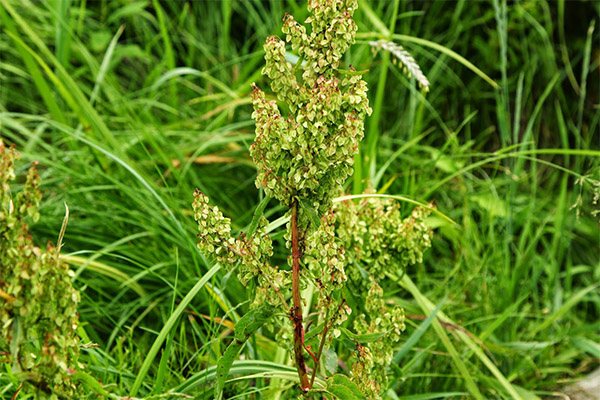

Ascorbic acid (vitamin C) is responsible for normal fat content, thiamine (vitamin B1) and organic acids help to maintain youth longer and have a firming effect, and flavonoids, by stimulating collagen formation, allow the skin to be elastic and elastic. Phylloquinone (vitamin K) and niacin (vitamin PP) make the face look fresh and radiant.
It is not difficult to prepare masks at home, you can use all parts of the plants - from the root to the inflorescence. The sorrel is washed, poured over with boiling water and then finely chopped with a knife. Now you can wrinkle with your hands until the juice separates.
Before applying an oxalic mask to your face, you need to conduct a sensitivity test to make sure that the acids contained in the sorrel will not harm your skin. Put a little mass prepared for the mask on the wrist or the bend of the elbow from the inside and wait a little. If the skin in this place begins to itch, burn and redden, you will have to give up the idea of making a mask.
To reduce the negative effects of sorrel on the skin, add additional components to the mask and do not keep the product longer than 10 minutes. Wash off with a soothing herbal decoction and then apply a moisturizer to your face.
Oily skin can be pampered with an oxalic mask every other day, normal - no more than twice a week, and dry - no more than once every 10 days. It is best to carry out such a vitamin course for a month, and then give the skin the same amount of rest.
You should never try to use any mask or sorrel lotion if the skin is highly sensitive or at the moment there is any irritation on it.
For acne
Cut a tablespoon of sorrel leaves, add the same amount of dried calendula or chamomile flowers to the composition and pour into 250 ml of boiling water. Boil for another 5 minutes and cool. Separate the broth with gauze or a fine strainer and dilute it with mineral water. Mineral water should be the same as broth. Apply the resulting gruel to your face for 10 minutes. Wash off with broth with mineral water.
For dry skin
Mix a full, with a slide, a tablespoon of good fat sour cream and a teaspoon of sunflower oil with 2 tablespoons of finely chopped young sorrel leaves. The resulting composition is generously put on the face, and after 20 minutes, wash with warm water.
For oily skin
Chop the sorrel leaves to make 50 g of green mass. Add chicken egg white and 10 ml of lemon juice to it. Stir gently, put the mixture on your face for 10-15 minutes. Moisten a cotton pad with green tea and remove the healing agent with it. This mask will not only refresh, but also tighten the pores on the skin.
Whitening mask
Put chopped sorrel leaves, spinach and parsley in a bowl, taking the herbs in equal parts - about half a tablespoon each. Then add a little kefir to this green mass, two tablespoons are enough. Stir and gently distribute on your face (so that the mass does not drain, you will have to lie down for a while). Hold for a quarter of an hour, remove the rest with cold water.
Purifying mask
Take a tablespoon each of three ingredients: chopped sorrel leaves, yarrow and Hercules flakes. Combine, pour in boiled water until sour cream, mix well again and apply on face. Keep for 15 minutes, rinse with cool water.
Ice cubes with sorrel
Pour a glass of boiling water over a mixture of 2 tablespoons of chopped sorrel leaves, a tablespoon of coltsfoot. Close the lid tightly so that everything is well steamed. Insist for at least 3 hours. Then strain and pour the broth into ice cube trays. Put in the freezer, then use to wipe your face in the morning and evening.
The herbal gruel remaining from the decoction can be applied to the face, after 15 minutes, rinse with cool boiled water.
Lotion on cognac
Pour 100 g of cognac with a mixture of crushed sorrel leaves, calendula flowers and chamomile (take 5 pcs.), 4 plantain leaves. Put in the refrigerator for 10 days, then strain. Put it in the refrigerator and wipe your face with it every day after waking up and before going to bed.
Hair infusion
It is good to rinse your hair with the root of horse sorrel in the form of an infusion if the scalp itches. To prepare it, cook 45 g of crushed root in two liters of water for 10-15 minutes, then leave for about an hour - and you can rinse your hair after washing. If you regularly use this tool, the hair follicles will recover, the hair will become healthy and shiny, and will acquire volume.
Can you eat horse sorrel?
Both the leaves and the stalks of horse sorrel are eaten. Its leaves are used to make salads, pie fillings, various soups and other culinary masterpieces. Horse sorrel is tasty in one dish with cucumbers or tomatoes. Good companions for him are radishes, young garlic and green onions. But it is necessary to apply only young, small leaves that are not so bitter. In the Caucasus (mainly in Armenia), braids are braided from the leaves and dried in the fresh air. As a result, they ferment and darken like tea, the bitterness disappears, and a spicy taste appears. Such braids are called aveluk. They can be bought in the markets; this dish is on the menus of restaurants and cafes. Aveluk is served with feta cheese and cheeses, it goes well with flat cakes or lavash, with the addition of matsun sauce. It is also used in soups and sauces.


Three minutes salad
It is called so because it will take exactly that much to prepare it - 3 minutes, no longer. Wash 2-3 young leaves of horse sorrel under running water, shake off the water, cut the leaves finely enough. Also cut 2 hard-boiled eggs. Stir herbs and eggs, salt and pepper, add a little granulated sugar. Sour cream is used as a dressing in this salad.
Vitamin salad
To prepare such a salad, you will need an equal share of cucumbers, tomatoes and fresh young leaves of horse sorrel. Chop, add a small amount of finely chopped sweet radish and chopped green onions. Salt, mix, season with mayonnaise. You can supplement the salad with boiled cold meat, green peas - you get a full-fledged hearty dish.
Salmon with horse sorrel
Cut 700 g of salmon into fillets and chop. Fry a little in vegetable oil and put in a thick-walled saucepan. Break 5–7 young sorrel leaves in a blender, tear 3 more leaves with your hands. Fry finely chopped onions in a frying pan, add torn sorrel and sorrel mass from a blender to it, pour 200 ml of cream and 200 g of processed cheese cut into small cubes. Season with salt, add ground black pepper, simmer for 7-10 minutes. Pour the resulting sauce over the fish, cover the pan with a lid and send to the hot oven for 20 minutes. Cook at 180 degrees. This dish is best served hot.
Cabbage soup with horse sorrel
Put chopped potatoes in the broth. While it is cooking, prepare the frying: fry the grated carrots with chopped onions in a pan in vegetable oil. When the potatoes are cooked, put the frying in a saucepan, cook for 3 minutes and put chopped horse sorrel leaves.To do this, take only young leaves! Following the sorrel, send slightly beaten eggs into the pan (three are enough for three liters of soup). Season with salt, wait for a simmer, turn off the heat and cover. Such cabbage soup is good with sour cream.
Fried pies
In 600 g of sifted flour, put 250 g of cottage cheese, rubbed through a sieve, mix well. Separately beat one egg with 200 ml of kefir, add to this tablespoon of granulated sugar, a pinch of salt and a teaspoon of baking soda, quenched with vinegar. With constant stirring, pour into flour with cottage cheese. Mix well and knead the dough. Let the dough stand for 40-50 minutes, covering it with a towel. Prepare the filling: sprinkle the chopped young leaves of horse sorrel with granulated sugar. Roll out small cakes from the dough, spread the filling on them, close the pies, pinching the edges, and fry in oil.
Sorrel jelly
Collect 200-250 g of horse sorrel leaves. Simmer them for 5-7 minutes in a saucepan with a tablespoon of water. Beat the resulting mass with a broom or blender. Pour in 2 cups of water, put 100 g of granulated sugar and send to the stove. As soon as it boils, pour cold water in a thin stream, in which a tablespoon of starch is diluted, into a saucepan. When it cools down, you can drink.
Champignons with horse sorrel
Boil 200 g of dried horse sorrel for 15 minutes. Drain the water with a colander, salt the sorrel. Chop two small onions finely and fry them in a skillet in vegetable oil over medium heat for a couple of minutes. Cut 100 g of mushrooms into medium-sized plates, put in a skillet with onions, fry everything together for another 5 minutes, stirring with a spatula. Add cold sorrel. To cool well, put out in the cold for a couple of hours. Before serving, sprinkle with finely chopped parsley, chop chopped walnuts and add sour cream.
Can you give rabbits horse sorrel?
Horse sorrel for rabbits - both decorative and meat breeds - is an irreplaceable delicacy from which they get great pleasure. They are attracted by the light sweetish aftertaste that the leaves have. Thanks to the huge amount of vitamins, primarily C, the herb is also beneficial for health, the body of animals from this only becomes healthier and stronger. The animals eating horse sorrel are less stressed and more energetic.
But everything is fine in moderation, so you cannot give sorrel without restrictions, since its components, when ingested, can cause kidney problems in rabbits. Allergies, heartburn, metabolic disorders are also possible. Therefore, horse sorrel alone cannot be given to rabbits, you need to combine it with wheatgrass, dandelion, plantain, yarrow and other herbs. You should not feed this plant to small rabbits, you need to give the kids a little growth.
In winter, it is also useful to prepare hay with horse sorrel for rabbits. Sorrel hay, when stored properly - in a dark hay barn or in the attic - retains nutrients without loss of quality for up to three years.
We advise you to read:
can rabbits be given rape
To read


